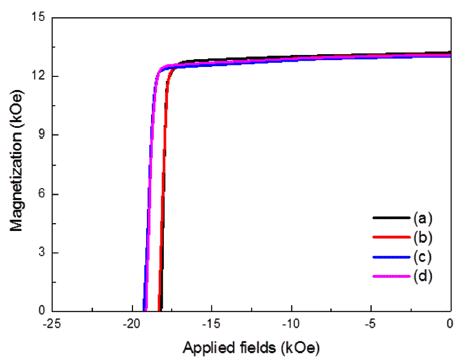Search
- Page Path
- HOME > Search
- [Korean]
- Synthesis of DyF3 paste and Magnetic Properties of GBDPed Nd-Fe-B Magnets
- Kwang-Won Jeon, Hee-Ryoung Cha, Jung-Goo Lee
- J Korean Powder Metall Inst. 2016;23(6):437-441. Published online December 1, 2016
- DOI: https://doi.org/10.4150/KPMI.2016.23.6.437

- 440 View
- 2 Download
-
 Abstract
Abstract
 PDF
PDF Recently, the grain boundary diffusion process (GBDP), involving heavy rare-earth elements such as Dy and Tb, has been widely used to enhance the coercivity of Nd-Fe-B permanent magnets. For example, a Dy compound is coated onto the surface of Nd-Fe-B sintered magnets, and then the magnets are heat treated. Subsequently, Dy diffuses into the grain boundaries of Nd-Fe-B magnets, forming Dy-Fe-B or Nd-Dy-Fe-B. The dip-coating process is also used widely instead of the GBDP. However, it is quite hard to control the thickness uniformity using dip coating. In this study, first, a DyF3 paste is fabricated using DyF3 powder. Subsequently, the fabricated DyF3 paste is homogeneously coated onto the surface of a Nd-Fe-B sintered magnet. The magnet is then subjected to GBDP to enhance its coercivity. The weight ratio of binder and DyF3 powder is controlled, and we find that the coercivity enhances with decreasing binder content. In addition, the maximum coercivity is obtained with the paste containing 70 wt% of DyF3 powder.
- [English]
- Spark Plasma Sintering Behaviors of M-type Barium Hexaferrite Nano Powders
- Im Doo Jung, Youngmoo Kim, Yang-Ki Hong, Seong Jin Park
- J Korean Powder Metall Inst. 2014;21(4):256-259. Published online August 1, 2014
- DOI: https://doi.org/10.4150/KPMI.2014.21.4.256

- 760 View
- 4 Download
- 5 Citations
-
 Abstract
Abstract
 PDF
PDF A magnetic powder, M-type barium hexaferrite (BaFe12O19), was consolidated with the spark plasma sintering process. Three different holding temperatures, 850°C, 875°C and 900°C were applied to the spark plasma sintering process with the same holding times, heating rates and compaction pressure of 30 MPa. The relative density was measured simultaneously with spark plasma sintering and the convergent relative density after cooling was found to be proportional to the holding temperature. The full relative density was obtained at 900°C and the total sintering time was only 33.3 min, which was much less than the conventional furnace sintering method. The higher holding temperature also led to the higher saturation magnetic moment (σs) and the higher coercivity (Hc) in the vibrating sample magnetometer measurement. The saturation magnetic moment (σs) and the coercivity (Hc) obtained at 900°C were 56.3 emu/g and 541.5 Oe for each.
-
Citations
Citations to this article as recorded by- Effect of microwave sintering on density, microstructural and magnetic properties of pure strontium hexaferrite at low temperatures and heating rate
Wail M. Matran, Mazli Mustapha, Mohd Faizairi Nor, Faizal Mustapha, Fahd Saeed Alakbari, Gamal Al-shawesh, Mohammed Bawahab
Heliyon.2024; 10(20): e38766. CrossRef - A study of crystalline – texture and anisotropic properties of hexagonal BaFe12O19 sintered by in-situ magnetic-anisotropy spark plasma sintering (MASPS)
Haetham G. Mohammed, Thar Mohammed Badri Albarody, Husam Kareem Mohsin Al-Jothery, Mazli Mustapha, N.M Sultan
Journal of Magnetism and Magnetic Materials.2022; 553: 169268. CrossRef - Process Optimization of In Situ Magnetic-Anisotropy Spark Plasma Sintering of M-Type-Based Barium Hexaferrite BaFe12O19
Haetham Mohammed, Thar Albarody, Susilawati Susilawati, Scott Gohery, Aris Doyan, Saiful Prayogi, Muhammad Bilad, Reza Alebrahim, Anwar Saeed
Materials.2021; 14(10): 2650. CrossRef - Self-Consolidation and Surface Modification of Mechanical Alloyed Ti-25.0 at.% Al Powder Mixture by Using an Electro-Discharge Technique
S.Y. Chang, H.S. Jang, Y.H. Yoon, Y.H. Kim, J.Y. Kim, Y.K. Lee, W.H. Lee
Archives of Metallurgy and Materials.2017; 62(2): 1293. CrossRef - Plastic deformation and microstructural evolution during the shock consolidation of ultrafine copper powders
Dong-Hyun Ahn, Wooyeol Kim, Minju Kang, Lee Ju Park, Sunghak Lee, Hyoung Seop Kim
Materials Science and Engineering: A.2015; 625: 230. CrossRef
- Effect of microwave sintering on density, microstructural and magnetic properties of pure strontium hexaferrite at low temperatures and heating rate
TOP
 KPMI
KPMI


 First
First Prev
Prev


